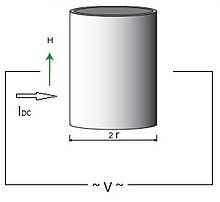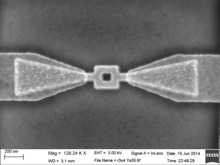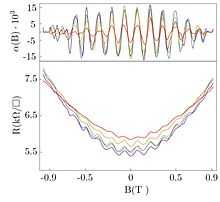Little–Parks effect
The Little–Parks effect was discovered in 1962 by William A. Little and Roland D. Parks in experiments with empty and thin-walled superconducting cylinders subjected to a parallel magnetic field.[1] One of the first indications to the importance of the Cooper-paring principle.
The essence of Little–Parks (LP) effect is slight suppression of the superconductivity by persistent current.
Results schematically shown in the Fig., where we see periodical oscillations of critical temperature (Tc), superimposed on the parabolic background.
Explanation
The electrical resistance of such cylinders shows a periodic oscillation with the magnetic flux piercing the cylinder, the period being
- h/2e ≈ 2.07×10−15 T⋅m2
where h is the Planck constant and e is the electron charge. The explanation provided by Little and Parks is that the resistance oscillation reflects a more fundamental phenomenon, i.e. periodic oscillation of the superconducting Tc.

The LP effect consists in a periodic variation of the Tc with the magnetic flux, which is the product of the magnetic field (coaxial) and the cross sectional area of the cylinder. Tc depends on the kinetic energy (KE) of the superconducting electrons. More precisely, the Tc is such temperature at which the free energies of normal and superconducting electrons are equal, for a given magnetic field. To understand the periodic oscillation of the Tc, which constitutes the LP effect, one needs to understand the periodic variation of the kinetic energy. The KE oscillates because the applied magnetic flux increases the KE while superconducting vortices, periodically entering the cylinder, compensate for the flux effect and reduce the KE.[1] Thus, the periodic oscillation of the kinetic energy and the related periodic oscillation of the critical temperature occur together.
The LP effect is a result of collective quantum behavior of superconducting electrons. It reflects the general fact that it is the fluxoid rather than the flux which is quantized in superconductors.[2]
The LP effect can be seen as a result of the requirement that quantum physics be invariant with respect to the gauge choice for the electromagnetic potential, of which the magnetic vector potential A forms part.
Electromagnetic theory implies that a particle with electric charge q travelling along some path P in a region with zero magnetic field B, but non-zero A (by  ), acquires a phase shift
), acquires a phase shift  , given in SI units by
, given in SI units by
In a superconductor, the electrons form a quantum superconducting condensate, called a Bardeen–Cooper–Schrieffer (BCS) condensate. In the BCS condensate all electrons behave coherently, i.e. as one particle. Thus the phase of the collective BCS wavefunction behaves under the influence of the vector potential A in the same way as the phase of a single electron. Therefore the BCS condensate flowing around a closed path in a multiply connected superconducting sample acquires a phase difference Δφ determined by the magnetic flux ΦB through the area enclosed by the path (via Stokes' theorem and  ), and given by:
), and given by:
This phase effect is responsible for the quantized-flux requirement and the LP effect in superconducting loops and empty cylinders. The quantization occurs because the superconducting wave function must be single valued in a loop or an empty superconducting cylinder: its phase difference Δφ around a closed loop must be an integer multiple of 2π, with the charge q = 2e for the BCS electronic superconducting pairs.
If the period of the Little–Parks oscillations is 2π with respect to the superconducting phase variable, from the formula above it follows that the period with respect to the magnetic flux is the same as the magnetic flux quantum, namely
Applications
Little–Parks oscillations is a widely used proof mechanism of Cooper pairing. One of the good example is the study of the Superconductor Insulator Transition.[3] [4]


The challenge here is to separate LP oscillations from weak (anti-)localization (Altshuler et al. results, where authors observed the Aharonov–Bohm effect in a dirty metallic films).
History
Fritz London predicted that the fluxoid is quantized in a multiply connected superconductor. Experimentally has been shown,[5] that the trapped magnetic flux existed only in discrete quantum units h/2e. Deaver and Fairbank were able to achieve the accuracy 20–30% because of the wall thickness of the cylinder.
Little and Parks examined a "thin-walled" (Materials: Al, In, Pb, Sn and Sn–In alloys) cylinder (diameter was about 1 micron) at T very close to the transition temperature in an applied magnetic field in the axial direction. They found magnetoresistance oscillations with the period consistence with h/2e.
What they actually measured was a immeasurable small changes of resistance versus temperature for (different) constant magnetic field, as it shown in Fig.
References
- ↑ 1.0 1.1 W. A. Little and R. D. Parks, “Observation of Quantum Periodicity in the Transition Temperature of a Superconducting Cylinder”, Physical Review Letters 9, 9 (1962), doi:10.1103/PhysRevLett.9.9
- ↑ Tinkham, M. (1996). Introduction to Superconductivity, Second Edition. New York, NY: McGraw-Hill. ISBN 0486435032.
- ↑ G. Kopnov et al., “Little-Parks Oscillations in an Insulator”, Physical Review Letters 109, 167002 (2012), doi:
- ↑ I. Sochnikov et al., “Large oscillations of the magnetoresistance in nanopatterned high-temperature superconducting films”, Nature Nanotechnology 5, 516–519 (2010), doi:
- ↑ Bascom S. Deaver, Jr. and William M. Fairbank, “Experimental Evidence for Quantized Flux in Superconducting Cylinders”, Physical Review Letters 7, 43 (1961), doi:


